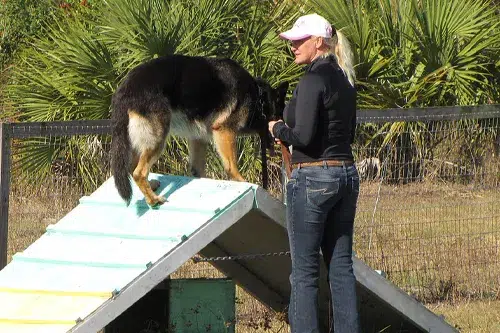How to Become a Dog Trainer: 5 Successful Tips


In the universe of animal lovers, the profession of dog trainer stands out as one of the most rewarding and challenging. By combining a passion for dogs with specialized knowledge of canine behavior, trainers play a crucial role in society, promoting harmony and understanding between humans and their four-legged companions. This article explores the field of canine training, the path to becoming a dog trainer, and the diverse professional opportunities that this career can offer.
What is dog training and what is it for?
Dog training emerges as a key aspect in building a healthy and harmonious relationship between dogs and their tutors. Grounded in ethical and scientific practices, canine training covers more than simply teaching tricks or commands; it is a holistic approach that aims to understand and shape the behavior of dogs, promoting their psychological and physical well-being.
The Basics of Dog Training
At the heart of dog training is positive reinforcement, a methodology that encourages and rewards desirable behaviors rather than punishing the unwanted. This technique is based on the idea that dogs are more likely to repeat behaviors that result in positive consequences, such as affection, toys, or treats.
Thus, training becomes a pleasant and enriching experience for both the dog and the tutor.
Objectives of the Dog Training
Dog training serves several essential purposes, each contributing to a stronger and happier relationship between dogs and humans:
- Basic Education: Teaching basic commands, such as “sit”, “stay”, “come” and “lie down”, is crucial for the safety of the dog and the ease of management by the tutor. These commands create a clear communication base between the dog and its human.
- Correction of Unwanted Behaviors: Behaviors such as barking excessively, chewing unwanted objects, or pulling the leash can be corrected through appropriate training techniques, improving the quality of life of both the dog and his tutor.
- Socialization: An integral part of canine training is socialization, that is, controlled exposure to different people, animals, and environments. This is particularly crucial during the first months of a dog’s life, helping to prevent fear and aggression in new or unknown situations.
- Advanced Obedience and Specific Training: Some tutors may wish to advance to higher levels of training, including advanced obedience or specializations such as odor detection, canine sports, or even assistance work.
Benefits of the Dog Training
In addition to direct objectives, dog training has broader benefits:
- Strengthening the Bond: The training process strengthens the bond between the dog and its tutor, building a relationship of mutual trust and understanding.
- Prevention of Behavioral Problems: A well-trained dog is usually calmer, happier, and less likely to develop serious behavioral problems.
- Social Integration: Well-trained and socialized dogs are easier to integrate into different social environments, making it easier to take them to public places, meet friends, or family vacations.
In short, dog training is much more than just learning commands; it is a path to harmonious and happy coexistence with these loyal companions. By investing in your dog’s training, you are investing in their health, happiness, and safety, as well as the quality of your coexistence.
How to Become a Dog Trainer?
Becoming a dog trainer requires a combination of formal education, practical experience, and a deep passion for animals. Although there is no single route, here are 3 tips for those who want to follow this career:
- Formal Education: A specialized course in dog training is an excellent starting point. Nubika’s course, for example, offers comprehensive training covering everything from the fundamentals of canine behavior to advanced training techniques, preparing students to tackle a wide range of behavioral challenges.
- Practical Experience: Complementing theoretical training with practical experience is fundamental. This can include internships with experienced trainers, volunteer work in shelters, or even practice with the dogs themselves or friends and family.
- Professional Certification: Although not mandatory, obtaining a certification can enrich the curriculum, demonstrating knowledge and commitment to the profession. Several organizations offer recognized certifications in the area of canine training.
- Join a professional association: Being part of a regional or national association of trainers is a great way to cultivate good networking, improve as a professional, and stay abreast of the main news in the sector.
- Learn to identify emotional problems in dogs: Especially in the case of bad behavior, the origin may be related to emotional problems, such as anxiety, fear, or some trauma. When working on re-education and behavioral change, it is up to you to identify the causes of the problem to be able to minimize or eliminate negative feelings and solve what is hindering.






